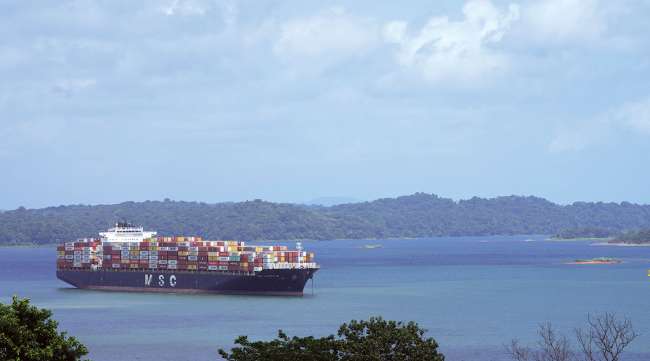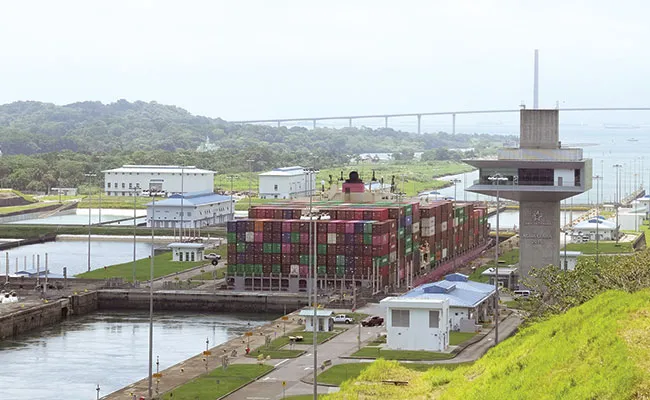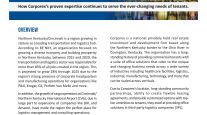Staff Reporter
Panama Canal Congestion Threatens US Trucking

[Stay on top of transportation news: Get TTNews in your inbox.]
Panama Canal officials say limiting how many ships can go through the waterway could have downstream effects on U.S. trucking like slowdowns and bottlenecks.
The Panama Canal Authority implemented those restrictions in response to a drought that caused low water levels at one of the major locks along the canal. But these limits have caused a backlog of ships either having to wait or find a longer route around.
“Our supply chain is very delicately balanced,” said Danny Ramon, intelligence and response manager at Overhaul. “If one thing goes out of whack a little bit, it can throw the whole system into chaos. We saw that with the Ever Given in the Suez Canal a couple of years ago. That’s basically the same thing that’s going to be going on here.”
The Canal Authority’s data show nearly 3% of all global maritime trade transits the canal. The United States is the main source of traffic, with close to 72.1% of cargo passing through the canal either originating from or arriving at a U.S. port. That accounted for 215.9 million long tons in 2022. This traffic mainly came from East Coast and Gulf of Mexico ports.

Ramon
“If we block up a major artery of international freight commerce, it’s going to have downstream effects on almost every link of the supply chain,” Ramon said. “When we look specifically at U.S. trucking, once there’s a choke point there at the canal, it means that choke points are just going to end up moving down the line.”
TD Cowen has been monitoring the drought conditions impacting the canal as well as the resulting supply chain bottleneck. The investment banking company noted in a report that the situation has created diversions and is also impacting ocean spot pricing.
“While shipping data indicates a pileup of ships waiting at the ends of the waterway, reports suggest that containerships have not been materially impacted in the U.S. East Coast and Gulf ports,” TD Cowen analyst Jason Seidl wrote in the report. “Potential implications to ocean container rates will hinge on weather and reservoir replenishment, though ocean carriers are able to divert this bottleneck (via the Suez Canal) at the expense of an extra week of travel time.”
FourKites noted in a report that the canal congestion could mean less volume being delivered to East Coast ports in locations such as Savannah, Ga., Charleston, S.C., New York, New Jersey and Baltimore.

Koepke
“Our belief is that the port throughput on the West Coast is in a really good state right now because overall demand is soft. So, if this were to happen a year ago, then this would just be exacerbated,” said Glenn Koepke, general manager of network collaboration at FourKites.
Koepke expects to see more shippers finding alternative routes for their cargo as canal wait times continue to grow. That would mean trucks for time-critical cargo and rail for everything else.
“There are no real issues for the container vessels,” said Christian Sur, executive vice president of ocean freight and contract logistics at Unique Logistics International. “But since the canal authority has said they’re going to be operating under this limited draft and a number of transfer dates, in another 10 months there could potentially be some conditions and delays.”
Sur still doesn’t see disruptions having a major impact even down the line because of the long transit times.
“There’s not that much volume moving, and there are other ways to get to the East Coast,” Sur said. “The Panama Canal is the optimal option.”

A cargo ship sails through Agua Clara locks of the Panama Canal. (Arnulfo Franco/Associated Press)
Ramon pointed out that the problem isn’t just that freight heading into the ports may slow down. The backlog of ships eventually coming through could cause bottlenecks along the supply chain as capacity struggles to meet the surge in volumes.
“Essentially that volume is not going anywhere,” Ramon said. “It’s just been slowed in arriving at its destination. Once that backlog at the Panama Canal clears, all of that cargo is going to arrive all at once.”
The Canal Authority has not issued an official date for when the restrictions will be lifted. But it has provided dates for when the restrictions will be re-evaluated. The severity of the situation and its downstream affects will ultimately depend on how long it lasts.
“The longer it goes on, the longer we’re dealing with the delay of goods reaching our shores, the more we’re going to deal with retail shortages and price spikes, especially going into the holiday season,” Ramon said. “It’s just a waterfall effect that, like I said, will go down through every link of the supply chain.”
Want more news? Listen to today's daily briefing below or go here for more info:




